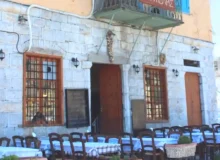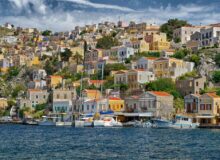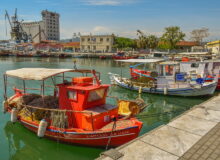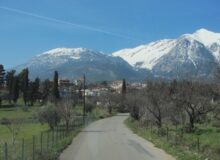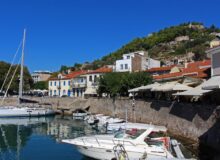The See Greece guide to Skyros in the Sporades with a brief history and travel information on how to get there by ferry or by air and what to see and do.

Introduction
Skyros, the southernmost island in the Sporades archipelago, is a captivating blend of rugged landscapes, pristine beaches, and rich cultural heritage. Unlike its more touristy neighbors, Skiathos and Skopelos, Skyros remains relatively untouched, offering an authentic Greek island experience. With its charming main town, traditional villages, and stunning coastline, Skyros is perfect for travelers seeking tranquility, history, and natural beauty.
This guide covers everything you need to know about Skyros, including its location, history, top attractions, and how to get there by air and ferry.
Where Is Skyros Located?

Skyros is part of the Sporades island group in the Aegean Sea, northeast of Evia (Euboea) and southeast of the other main Sporades islands (Skiathos, Skopelos, and Alonissos). Despite being grouped with the Sporades, Skyros is geographically closer to Evia and is administratively part of the region of Central Greece.
The island is divided into two distinct regions:
– North Skyros: Lush, green, and mountainous, with dense pine forests.
– South Skyros: Barren and rocky, resembling the Cycladic islands.
The capital, Skyros Town (Chora), is perched on a hill in the north, offering breathtaking views of the Aegean.
A Brief History of Skyros
Skyros has a fascinating history that dates back to ancient Greek mythology and the Bronze Age.
Mythological Connections
– According to legend, Theseus, the mythical king of Athens, was exiled to Skyros and later killed by King Lycomedes.
– Achilles hid on Skyros disguised as a woman to avoid fighting in the Trojan War, but Odysseus discovered him and recruited him.
– Neoptolemus, Achilles’ son, was raised on Skyros before joining the Trojan War.
Ancient & Byzantine Era
– Skyros was inhabited since prehistoric times and became part of the Athenian Empire.
– During the Byzantine era, the island was fortified against pirate raids.
Venetian & Ottoman Rule
– The Venetians controlled Skyros in the 13th century, followed by the Ottomans in the 16th century.
– The island was liberated in 1829 during the Greek War of Independence.
Modern Skyros
Today, Skyros is known for its traditional festivals, unique Skyrian horses (a rare small breed), and vibrant arts scene. The island attracts visitors looking for an off-the-beaten-path destination.

What to See & Do on Skyros
1. Explore Skyros Town (Chora)
The island’s capital is a picturesque maze of whitewashed houses, narrow alleys, and medieval architecture. Key highlights include:
– The Castle of Skyros: A Venetian fortress built on ancient ruins, offering panoramic views.
– Monastery of Agios Georgios: A 10th-century monastery with stunning frescoes.
– Faltaits Historical & Folklore Museum: Showcasing local traditions, costumes, and artifacts.
– Manos Faltaits Museum: Dedicated to the famous Greek poet and artist.
2. Discover Palamari Archaeological Site
An ancient settlement dating back to 2500 BC, Palamari reveals remnants of a fortified Bronze Age city with houses, streets, and pottery.
3. Relax on Skyros’ Best Beaches
– Molos: The most popular sandy beach with shallow waters, ideal for families.
– Pefkos: A secluded beach with golden sand and turquoise waters.
– Kalamitsa: Close to Chora, great for swimming and water sports.
– Atsitsa: A pebbly beach surrounded by pine trees, perfect for a quiet retreat.
– Achilli: A remote, pristine beach accessible by boat or a rough road.
4. Visit the Skyrian Horse Trust
Skyros is home to the rare Skyrian horse, a small indigenous breed. The Skyros Horse Trust works to protect these animals, and visitors can see them in their natural habitat.
5. Experience Local Festivals & Traditions
– Carnival (Apokries): Skyros has one of Greece’s most unique Carnival celebrations, featuring goat dances (Geranos) and masked performers.
– Easter: A deeply religious event with processions and feasts.
– Feast of Agios Panteleimonas (July 27): A traditional festival with music, dancing, and local food.
6. Hiking & Nature Exploration
– Mount Kochylas: A scenic hike with stunning views.
– Trekking Routes: Explore ancient paths leading to secluded beaches and monasteries.
7. Enjoy Local Cuisine
Skyros offers delicious traditional dishes, including:
– Lobster pasta (Astakomakaronada)
– Goat stew (Katsikaki sti gastra)
– Skyrian cheese pies
– Local honey and herbal teas

How to Get to Skyros
By Air
– Skyros Island National Airport (SKU) has limited flights from Athens (Eleftherios Venizelos Airport) via Olympic Air (approx. 45-minute flight).
– Flights operate 2-3 times per week, mainly in summer.
By Ferry
Skyros is accessible by ferry from:
From Kymi (Evia) – The Most Common Route
– Kymi is the main port for Skyros ferries (about 3-4 hours from Athens by car/bus).
– Ferry duration: 2.5 to 3.5 hours (depending on the vessel).
– Operators: Skyros Shipping Company & Hellenic Seaways.
– Frequency: Daily in summer; reduced in winter.
From Other Sporades Islands (Skiathos, Skopelos, Alonissos)
– Less frequent connections, usually via Alonissos or Kimi.
From Thessaloniki (Indirect Route)
– Drive/bus to Kimi, then take the ferry.
Getting Around Skyros
– Buses: Limited service between Chora and Molos.
– Taxis: Available but not abundant.
– Car/Motorbike Rental: Recommended for exploring remote areas.
– Boat Tours: Visit secluded beaches like Achilli.

Final Tips for Visiting Skyros
– Best time to visit: May to September for warm weather and open tourist facilities.
– Avoid peak August crowds if you prefer a quieter experience.
– Cash is essential – many places don’t accept cards.
– Respect local customs, especially during religious festivals.















